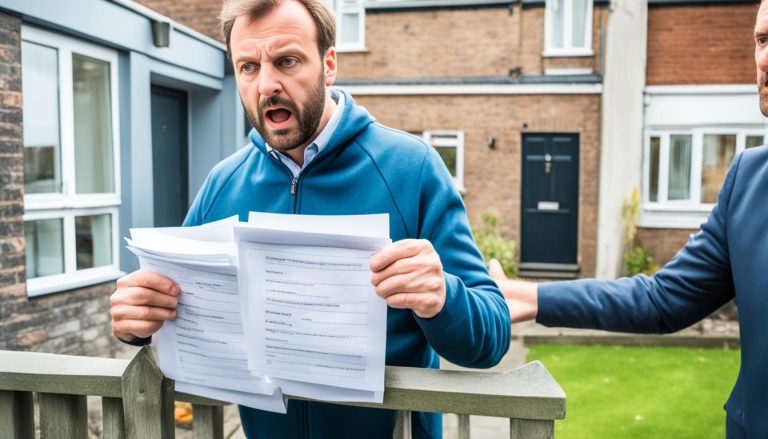Evicting a tenant in the UK is a process that involves legal procedures, court applications, and, in some cases, the involvement of bailiffs. One of the key concerns for landlords is understanding the associated costs, especially when bailiffs are needed to enforce a possession order.
This guide explains the process step by step, outlining the expenses landlords should expect and the legal responsibilities involved.
What Is the Legal Process for Evicting a Tenant in the UK?

Evicting a tenant involves several legal stages and must comply with UK housing laws. The process begins with serving an appropriate eviction notice. Landlords usually choose between:
- Section 21 Notice – used when the landlord wants to regain possession of the property at the end of a fixed-term tenancy or during a periodic tenancy without alleging any fault by the tenant.
- Section 8 Notice – used when the tenant has broken the terms of the tenancy agreement, such as non-payment of rent or causing damage to the property.
If the tenant does not leave within the notice period, landlords must apply to the court for a possession order. Only after this order is granted and the tenant fails to comply can the landlord apply for a warrant of possession, which allows bailiffs to carry out the eviction.
The key steps in the legal process include:
- Serving the correct notice
- Applying for a possession order through the County Court
- Requesting a warrant for possession if the tenant remains
At every stage, landlords must follow precise legal procedures and timeframes to avoid delays or case dismissal.
When Can a Landlord Apply for a Warrant for Possession?
A landlord is permitted to apply for a warrant for possession under two primary circumstances:
- The tenant has not vacated the property by the date specified in the possession order.
- The tenant breaches the terms of a suspended possession order, which may allow them to stay in the property under specific payment conditions.
The landlord can apply using:
- Form N325, which is submitted by post or in person to the court
- The Possession Claim Online (PCOL) system, but only if the possession order was issued through it
Importantly, landlords have up to six years from the date of the possession order to apply for a warrant, providing a lengthy window for enforcement.
How Much Does It Cost to Apply for a County Court Bailiff?
Applying for a County Court bailiff to enforce an eviction requires a fixed payment. As of the current court fee schedule:
- The fee is £148, payable at the time of application.
This cost is for issuing the warrant for possession, which authorises a County Court bailiff to remove the tenant if they remain in the property. Once submitted, the court will issue:
- A warrant number
- An EX96 Notice of Appointment, which confirms the date and time of eviction
The landlord must return the completed EX96 form to the court to proceed. Failing to do so may result in the cancellation of the scheduled eviction.
What Happens After a Warrant for Possession Is Issued?

Once a warrant is granted, the court informs both the landlord and the tenant. The tenant receives an official eviction notice, clearly stating the date and time by which they must vacate the property.
Meanwhile, the landlord is expected to:
- Review the appointment date provided in the EX96 form
- Complete and return the form to the court
Failure to return the form on time can invalidate the eviction process, causing delays. Bailiffs typically attend the property on the scheduled date. If the tenant has not left voluntarily, they are removed in accordance with the law.
In many cases, the mere issuance of the warrant prompts tenants to leave before enforcement is required.
Can You Speed Up the Eviction by Using High Court Bailiffs?
High Court bailiffs, or High Court Enforcement Officers (HCEOs), offer a faster alternative to County Court bailiffs. This option is appealing to landlords seeking a quicker resolution. However, this route requires an additional step.
- Transfer of the case from the County Court to the High Court is required.
- A writ of possession must be obtained from the High Court.
The cost to transfer and apply for the writ is £123. Additionally, landlords may face enforcement fees depending on the company used. Before transferring the case, landlords must request and receive permission from the County Court.
Benefits of using High Court bailiffs include:
- Faster enforcement times (often within days or a couple of weeks)
- More flexibility in scheduling appointments
- Potential deterrence to tenants aware of stronger enforcement
However, landlords should weigh the higher costs and procedural steps before opting for this method.
What Are the Differences Between County Court and High Court Bailiffs?
The table below outlines the key differences between County Court and High Court bailiffs:
| Feature | County Court Bailiffs | High Court Enforcement Officers |
| Application Fee | £148 | £123 (for transfer) |
| Enforcement Speed | Slower – 4 to 6 weeks | Faster – as little as 7–14 days |
| Permission Requirement | Not required | Required from County Court |
| Additional Costs | Rare | Often £300–£600+ |
| Tenant Deterrent Effect | Moderate | Higher due to stronger authority |
While the High Court route is more efficient in many cases, it is not always necessary or financially justified, particularly for straightforward evictions.
Can a Tenant Delay or Stop the Bailiff Eviction?

Tenants can legally challenge an eviction, even after a warrant is granted. They may apply to the court to suspend the warrant for possession. This typically results in a new hearing where a judge considers their application.
Grounds for delay include:
- A change in financial circumstances
- A request to repay rent arrears under a revised agreement
The judge can:
- Delay the eviction temporarily
- Allow the tenant to remain if they commit to a revised payment plan
- Uphold the original eviction if no compelling reason is presented
It’s crucial for landlords to attend this hearing (if notified) and present evidence of prior attempts to collect rent or mediate the issue.
What Are the Total Eviction Costs a Landlord Should Expect?
While the £148 court fee is a base figure, the total cost of an eviction can vary depending on the methods used, legal assistance involved, and tenant response. Below is a table outlining typical cost scenarios:
| Expense Category | Estimated Cost (Range) |
| Serving Section 21 or 8 Notice | £0 – £100 (DIY or solicitor) |
| Court Possession Order Fee | £355 |
| County Court Bailiff Warrant | £148 |
| High Court Transfer Fee | £123 |
| HCEO Enforcement (if used) | £300 – £600+ |
| Legal Advice/Solicitor Fees | £100 – £1000+ |
| Total Estimate | £600 – £2,000+ |
These figures illustrate that while bailiff eviction might appear affordable at first glance, the cumulative legal, administrative, and enforcement expenses can escalate.
What Are Some Alternatives to Bailiff Eviction?

Evicting a tenant using bailiffs can be costly and time-consuming. Fortunately, several effective alternatives exist that can help landlords regain possession of their property without resorting to enforcement action. These methods are especially useful when the tenant is cooperative or in vulnerable circumstances.
Voluntary Surrender of the Property
Voluntary surrender involves the tenant agreeing to leave the property without legal enforcement. This method typically begins with a conversation between the landlord and tenant, followed by a formal agreement confirming the tenant’s intention to vacate. It avoids the need for court intervention and is often quicker and less stressful for both parties.
This approach works best when the tenant acknowledges the situation—such as rent arrears or breach of tenancy—and is willing to move out without resistance. The landlord should ensure the agreement is documented in writing and includes a clear date of surrender.
Involving the Local Council or Housing Support Services
Local councils can sometimes assist tenants who are at risk of eviction. If a landlord notifies the council about a tenant’s situation, the housing department may intervene to help the tenant secure alternative accommodation.
This route is particularly helpful when dealing with vulnerable tenants, such as families with children, those with disabilities, or those facing financial hardship. Council involvement may lead to the tenant moving out voluntarily, avoiding the need for further legal steps.
Mediation and Dispute Resolution
Mediation offers a structured environment for resolving conflicts between landlords and tenants without court action. A neutral third party facilitates discussion, aiming to reach a mutually agreeable solution. Issues such as unpaid rent, noise complaints, or property conditions can often be settled this way.
Many councils and housing organisations offer free or low-cost mediation services. It is a confidential and non-binding process but can be highly effective, especially in cases where communication has broken down but eviction can still be avoided.
Repayment Agreements for Rent Arrears
In cases of rent arrears, setting up a payment plan may resolve the issue without requiring possession proceedings. A landlord and tenant can negotiate an affordable repayment schedule that allows the tenant to stay in the property while clearing their debt over time.
The terms should be written, signed by both parties, and include a review mechanism. Regular communication and monitoring can help ensure the agreement is upheld. This solution is often seen as a fair compromise, especially when the tenant’s financial situation is temporary.
Serving a Notice Without Immediate Enforcement
Sometimes, the simple act of serving a valid Section 21 notice can prompt tenants to vacate without the need for court or bailiff action. This notice gives tenants time to make alternative arrangements and may encourage voluntary departure.
It is essential to ensure the notice is legally compliant and correctly served, as errors can lead to delays if legal proceedings do become necessary. Even though this notice is a formal step in the eviction process, it can often lead to resolution before enforcement is required.
Conclusion
For landlords facing tenants who refuse to leave a property, using bailiffs may be the only viable legal option. While the costs can add up, especially if High Court enforcement is used, the process ensures legal compliance and minimises future complications.
Understanding the costs, timeframes, and potential delays involved is crucial. By weighing all options—including mediation and voluntary solutions—landlords can make informed decisions that balance financial impact with legal certainty.
FAQs About Tenant Eviction and Bailiff Costs in the UK
How long does it take to evict a tenant with a bailiff?
It typically takes 4 to 6 weeks for a County Court bailiff to act after a warrant is issued. High Court bailiffs may operate more quickly, depending on availability.
Is it cheaper to use High Court bailiffs?
Not necessarily. While they can act faster, High Court bailiffs often charge higher fees, which may offset any savings from a quicker resolution.
Can landlords recover eviction costs from tenants?
In some cases, courts allow landlords to add costs to the tenant’s arrears. However, actual recovery depends on the tenant’s ability to pay.
What happens if a tenant refuses to leave after a court order?
If a tenant stays beyond the possession date, a landlord must apply for a warrant of possession. Bailiffs will then be authorised to enforce the eviction.
Are there free services to help landlords with eviction?
Yes, organisations like the National Residential Landlords Association (NRLA) and Citizens Advice offer guidance and legal resources to landlords.
Can a tenant be evicted during winter or Christmas?
Yes, but courts may be more cautious about evictions during holidays. However, there is no legal prohibition against winter evictions.
Do landlords need a solicitor to evict a tenant?
No, landlords can handle the process themselves, especially for straightforward cases. However, legal advice is recommended for complex situations.






